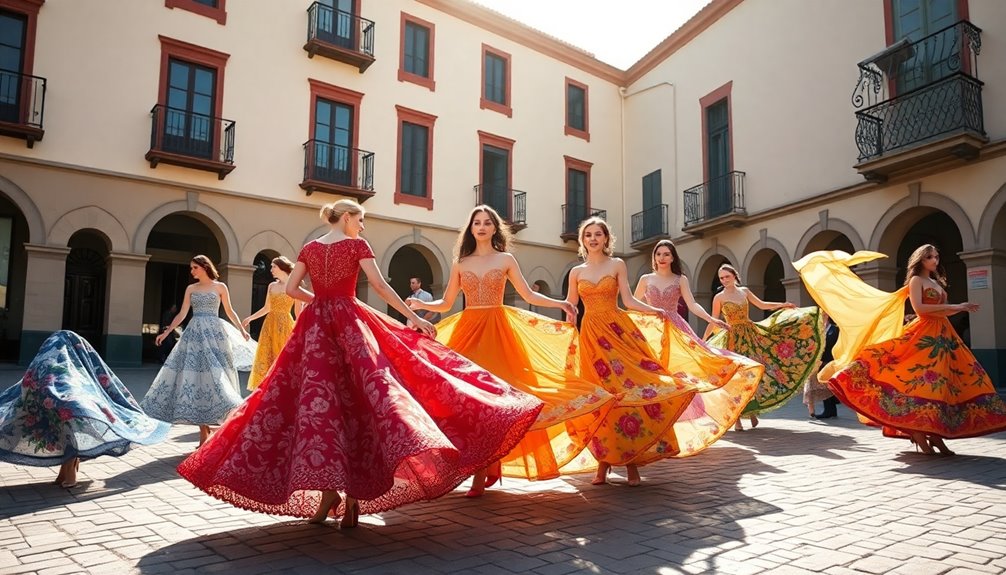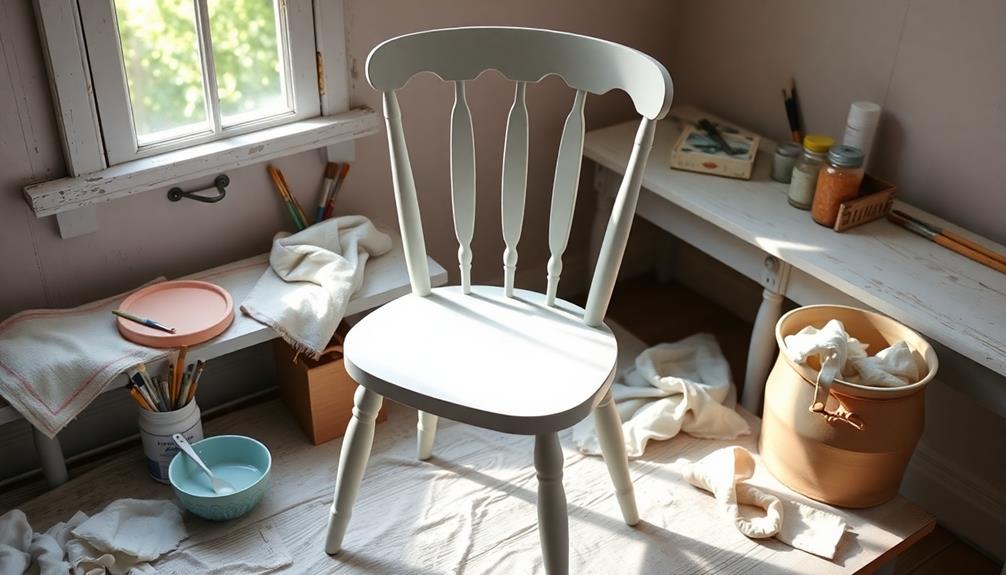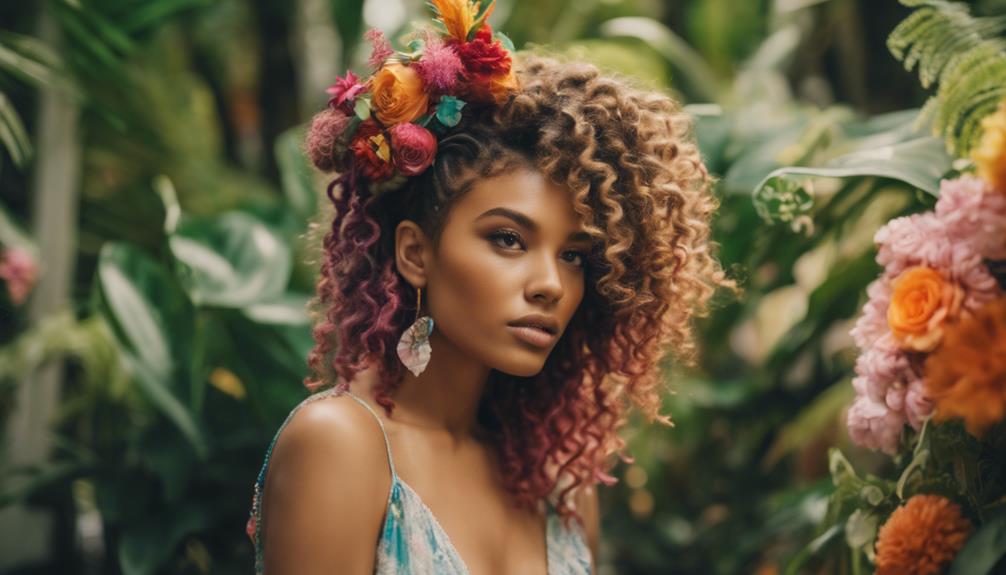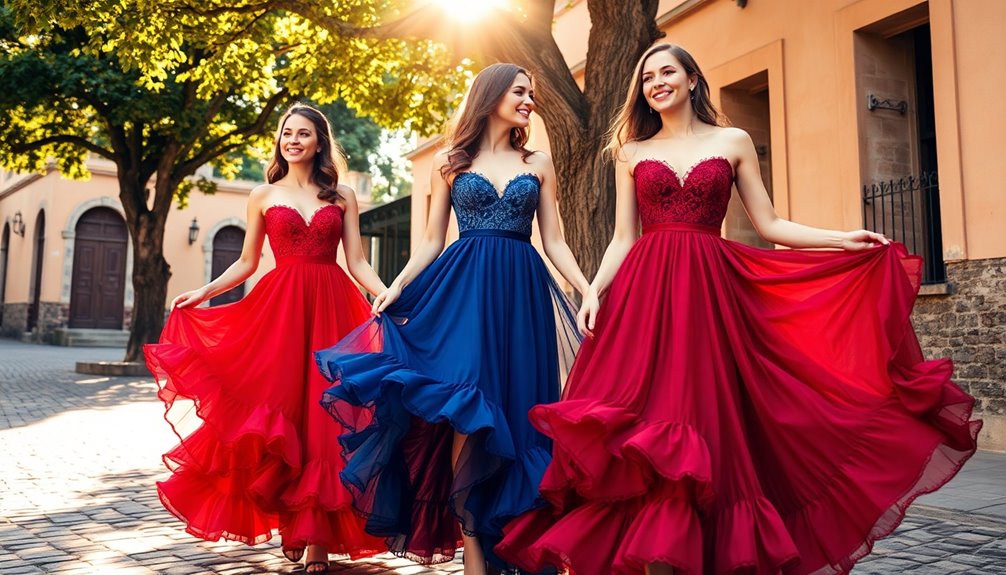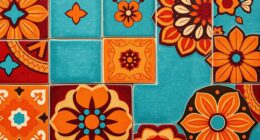Dresses from Spain offer you a unique passport to authentic European style. You'll find a stunning mix of traditional craftsmanship and contemporary designs. Expect tailored silhouettes, high-quality fabrics like linen and cotton, and earthy color palettes for timeless elegance. With options ranging from chic flamenco dresses to modern casual pieces, there's something to suit every occasion. Plus, the rise of sustainable fashion means investing in high-quality, eco-friendly garments that reflect your style. Embrace the vibrant cultural influences that shape Spanish fashion, and you're sure to turn heads wherever you go. Keep going to discover more about this enchanting style!
Key Takeaways
- Spanish dresses blend traditional craftsmanship with modern aesthetics, offering a unique style that reflects the country's rich cultural heritage.
- Key characteristics include tailored silhouettes, high-quality fabrics, and muted color palettes, ensuring elegance and sophistication in every piece.
- Sustainable fashion practices are increasingly integrated into Spanish dress design, utilizing eco-friendly materials and promoting responsible consumption.
- Explore local boutiques and pop-up shops for unique, handcrafted dresses that showcase Spain's vibrant fashion scene and craftsmanship.
- Influencers and fashion icons like Penélope Cruz embody the "Madrid Look," seamlessly combining contemporary and classic elements for a chic European style.
Origin and historical background of the fashion trend/style
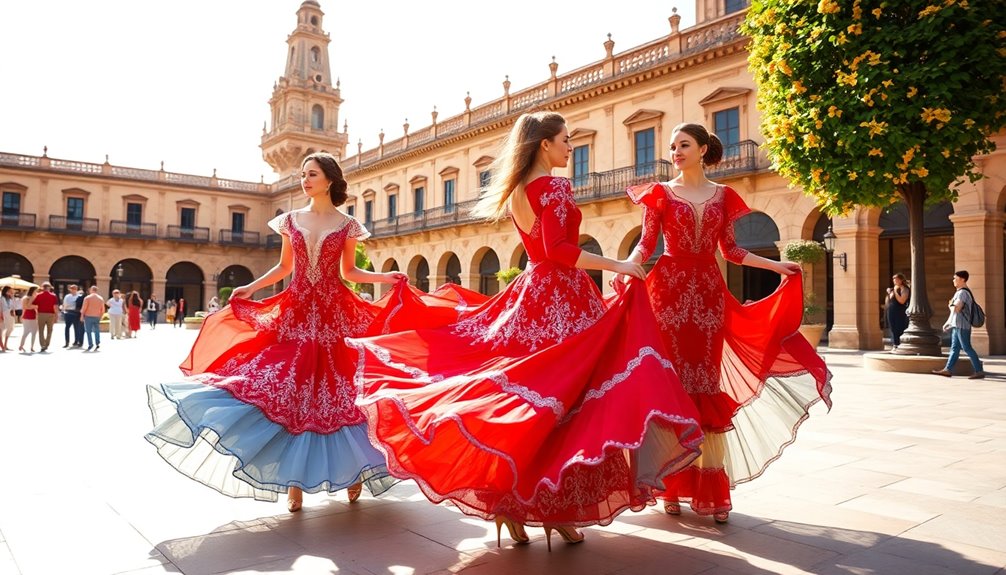
You can see how fashion in Spain has transformed over the decades, showcasing a rich tapestry of influences and styles.
Fashion icons, from the flamenco dancers of yesteryear to modern designers, have played a crucial role in shaping this evolution.
As you explore this journey, you'll discover how each era contributes to the vibrant dress culture we celebrate today.
Fashion's Transformation Over Decades
Over the decades, Spain's fashion landscape has undergone a remarkable transformation, evolving from conservative traditional attire to a vibrant, contemporary style that embraces global influences.
In the 20th century, you'd find yourself surrounded by rich regional customs, where traditional garments defined the Spanish identity. However, the 1980s brought the Movida Madrileña, igniting a rebellion against these norms with its bold colors and patterns. This shift marked a turning point in Spanish retail stores, where eclectic styles began to emerge.
By the 1990s, designers like Paco Rabanne gained international recognition, introducing innovative materials that put Spain on the European fashion map. Brands such as Zara and Mango capitalized on this momentum, making chic clothing accessible.
As the early 2000s rolled in, you'd see a fusion of high fashion and street style, allowing you to wear shorts paired with elegant tops, blending comfort with flair.
Today, Spanish fashion is a harmonious mix of traditional craftsmanship and modern aesthetics. Events like Madrid Fashion Week showcase this evolution, solidifying Spain's role as a key player in the global fashion scene. The rise of high fashion has also influenced personal styles, encouraging individuals to express their uniqueness through clothing choices.
Fashion Icons of the Era
The evolution of Spanish fashion has been shaped not only by trends but also by the influential figures who defined and redefined styles throughout the years. Iconic designers like Cristóbal Balenciaga and Paco Rabanne pushed boundaries in the 20th century, creating fashionable clothes that revolutionized women's wardrobes globally. Their innovative cuts and materials set the stage for what you now recognize as modern Spanish fashion.
In the late 20th century, the "Madrid Look" emerged, blending contemporary and classic elements. It showcased chic layering and bold accessories, capturing the attention of fashion enthusiasts in every European city. This unique style reflects Spain's cultural diversity, drawing from regional variations like the colorful shawls of Andalusia and the intricate embroidery of Catalonia.
Fashion icons such as actress Penélope Cruz and model Blanca Padilla have also played a significant role in this narrative. They've modernized traditional styles, making them relevant and desirable today.
Their influence extends beyond the runway, as they embody the essence of Spanish fashion, combining heritage and innovation seamlessly. With these icons leading the charge, you're witnessing a vibrant blend of history and modernity that defines contemporary Spanish fashion.
Key Characteristics
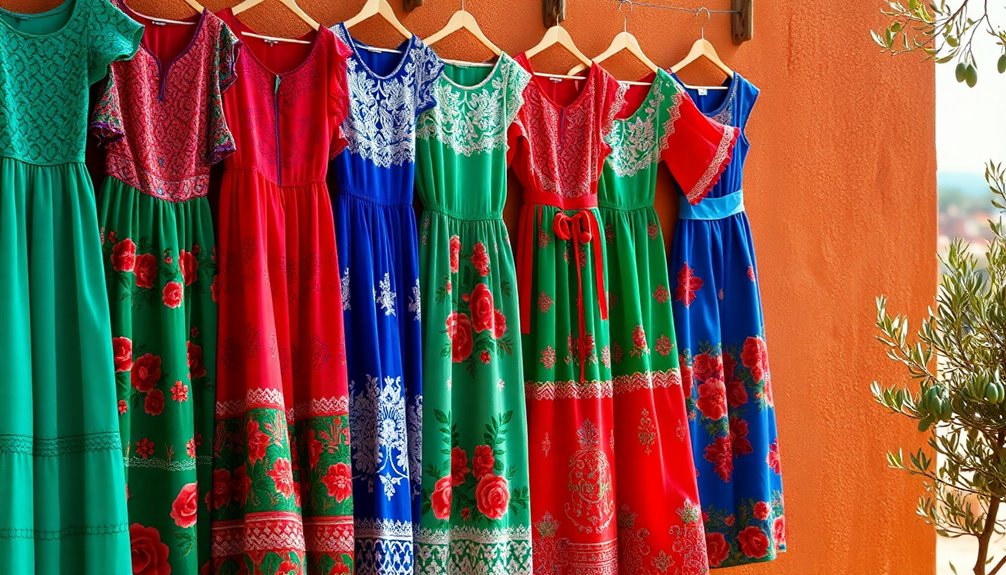
When you think of Spanish dresses, you'll notice the emphasis on tailored silhouettes and structured designs that complement your shape.
Fabrics like linen and cotton in muted tones create a refined yet comfortable look perfect for any occasion.
Pairing these dresses with classic tailored blazers elevates your style, making it effortlessly chic.
Tailored Silhouettes and Structured Designs
Dresses in Spain showcase tailored silhouettes and structured designs that flatter your figure beautifully. These dresses often emphasize the natural waistline, creating an alluring hourglass shape that enhances your femininity.
You'll find that many styles incorporate high-quality fabrics like cotton, linen, and silk, which not only elevate comfort but also contribute to a polished appearance.
Structured designs typically feature fitted bodices, A-line skirts, and defined shoulders, allowing you to achieve a sophisticated yet modern look. This versatility means you can effortlessly transition from day to night, simply by adding accessories or switching up your footwear. Whether you're heading to the office or out for dinner, these tailored silhouettes adapt to your needs.
Additionally, the muted and earthy color palettes, along with classic patterns like stripes or polka dots, reinforce the structured design aesthetic. This timeless elegance appeals to anyone looking to make a stylish statement.
With Spanish dresses, you embrace a refined style that combines both form and function, ensuring you feel confident and chic for any occasion. Discover how tailored silhouettes and structured designs can become staples in your wardrobe, elevating your everyday fashion choices.
Linen, Cotton, and Muted Tones
In the warm months, linen and cotton reign supreme in Spain's fashion scene, providing both breathability and comfort. These fabrics are perfect for the hot climate, allowing you to stay cool while looking stylish.
Lightweight linen dresses are particularly popular; they effortlessly keep you comfortable during daytime outings and transition beautifully for evening events.
Cotton dresses, on the other hand, offer versatility. You can easily dress them up or down, adding statement accessories to elevate your look from casual to polished. This adaptability makes cotton a staple in your wardrobe.
When it comes to colors, muted tones like beige, navy, and soft pastels dominate. These subtle shades reflect a sophisticated aesthetic that locals prefer, allowing for seamless outfit coordination.
You'll find that wearing garments in these colors emphasizes an understated elegance, aligning with broader European fashion trends.
Classic Tailored Blazers
Classic tailored blazers are a must-have in any wardrobe, offering a structured fit that elevates your style effortlessly. These blazers typically feature a single-breasted design with notched lapels, creating a polished silhouette suitable for both casual and formal occasions. Made from high-quality fabrics like wool, cotton, or linen, classic tailored blazers adapt well to various climates, ensuring you look put together year-round.
When you wear a well-fitted tailored blazer, you instantly enhance the appearance of any outfit. Pair it with jeans for a casual day out, or drape it over a dress for a refined look at a formal event.
Europeans wear these blazers in muted tones such as navy, black, and beige, reflecting their preference for timeless, conservative color palettes.
Functional details like pockets and buttoned cuffs add practicality to the style, while subtle patterns such as houndstooth or pinstripes bring an extra touch of sophistication.
With a classic tailored blazer in your collection, you'll always have a versatile piece that enhances your wardrobe and keeps your look effortlessly chic.
Modern Interpretation
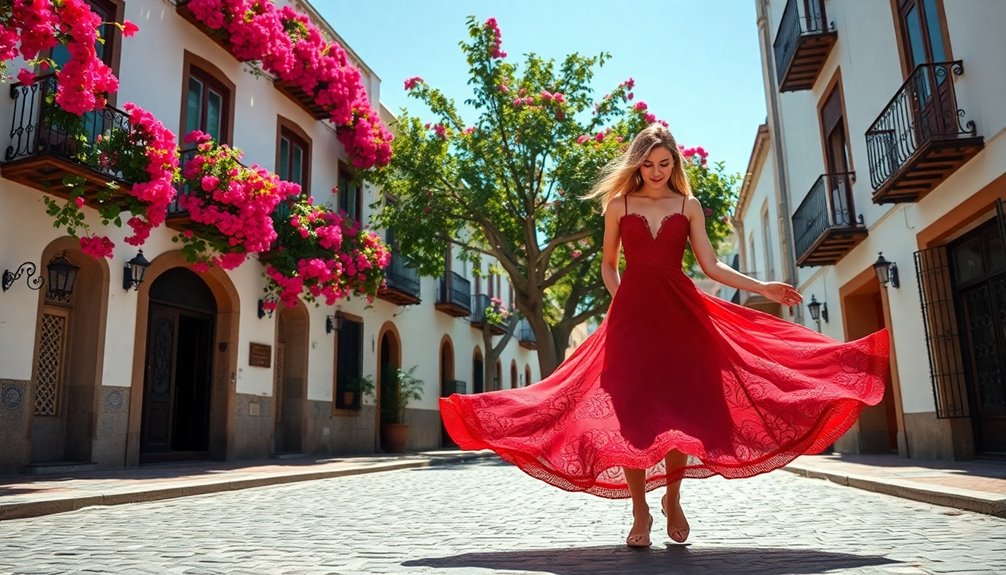
In today's fashion scene, you'll notice a growing emphasis on sustainable practices within Spanish dress design.
Emerging labels are making waves by marrying eco-friendly materials with innovative styles, while fashion-forward public figures are championing this movement.
You can see how these trends highlight a fresh, responsible approach to dressing that stays true to Spain's vibrant heritage.
Sustainable Fashion Initiatives
Sustainable fashion is transforming Spain's vibrant landscape, as brands embrace eco-friendly materials like organic cotton and recycled polyester. This shift isn't just a trend; it's a necessary evolution in how you think about your wardrobe.
With the rise of the Slow Fashion movement, you're encouraged to invest in high-quality, timeless pieces instead of succumbing to the fast fashion cycle that generates waste.
Notable Spanish brands like Ecoalf and Thinking Mu are leading the charge, crafting stylish clothing that prioritizes sustainability and ethical production methods. You'll find that these options not only look great but also reflect a commitment to the environment.
The Spanish government is also on board, promoting circular fashion initiatives to emphasize the importance of recycling and upcycling clothing.
Fashion events like Madrid Fashion Week are increasingly showcasing sustainable collections, allowing you to discover designers dedicated to environmentally conscious practices and responsible sourcing.
Emerging Sustainable Fashion Labels
Spain's fashion scene is buzzing with emerging labels that are redefining style through sustainability. Brands like Ecoalf and Thinking MU are at the forefront, prioritizing eco-friendly materials and ethical production practices to minimize their environmental impact.
Ecoalf, for instance, boasts that it creates garments from 100% recycled fabrics, including plastic bottles and discarded fishing nets. This commitment not only highlights the importance of sustainable fashion but also inspires you to make conscious choices.
Consumer interest in eco-conscious brands has surged by 30%, reflecting a growing demographic eager for stylish yet responsible clothing. Labels like Reformation and Veja are setting trends, merging fashionable designs with sustainable practices, making it easier for you to look good while feeling good about your purchases.
Moreover, Spain's fashion industry is becoming increasingly transparent, with brands sharing detailed information about their sourcing and manufacturing processes. This transparency builds trust and encourages you to support brands that align with your values.
As you explore these emerging sustainable fashion labels, you'll discover that you can embrace authenticity and style while championing a greener planet.
Fashion-Forward Public Figures
Fashion-forward public figures in Spain are redefining modern European chic with their vibrant style choices. They embrace bold colors and flowing silhouettes, ensuring comfort while making a statement.
You'll notice how influencers often mix casual and sophisticated pieces, turning heads by pairing tailored shorts with oversized blazers or layering a chic maxi dress with a denim jacket. This relaxed yet polished look is becoming popular all over Europe.
These fashion icons pay great attention to detail, accessorizing with statement jewelry and colorful scarves that elevate their outfits. They also embody a commitment to sustainable fashion, supporting local designers who prioritize eco-friendly materials and production methods.
By doing so, they not only showcase fashionable clothes but also promote a more conscious approach to style.
Pastel shades and earth tones dominate their wardrobes, reflecting broader seasonal trends while blending contemporary aesthetics with traditional Spanish influences.
By following these public figures, you can gain inspiration for your own wardrobe, merging vibrant colors and sustainable choices to create looks that resonate with authentic European style.
Embrace their fashion-forward spirit and elevate your own style game!
Styling Tips
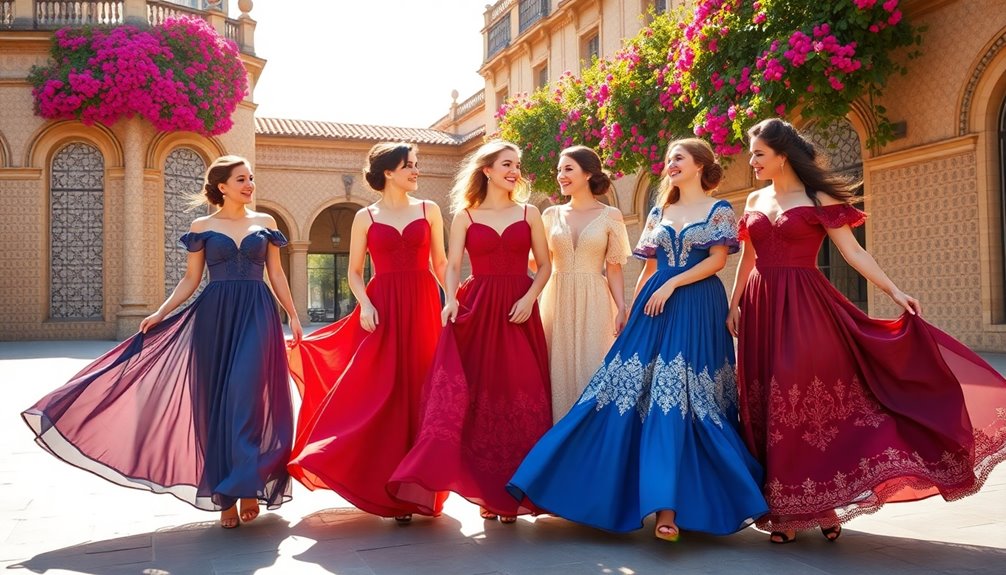
When it comes to styling your dresses in Spain, don't underestimate the power of timeless tailored trousers to create a chic layered look for spring.
Mixing textures and patterns can elevate your outfit while keeping you comfy and stylish.
Incorporating multi-functional furniture into your wardrobe can also help streamline your dressing process for those busy mornings.
Let's explore how to master these techniques for a truly authentic European vibe.
Timeless Tailored Trousers
Timeless tailored trousers are a must-have in your wardrobe, effortlessly bridging the gap between comfort and style. These versatile staples in muted colors like black, navy, or beige easily coordinate with various tops, making them perfect for both casual outings and semi-formal events during your travels in Spain.
When selecting tailored trousers, ensure they fit well to enhance your overall appearance, allowing you to enjoy extensive sightseeing without sacrificing style. Pair them with a fitted button-up shirt or a chic blouse for a polished look that's suitable for evening outings or dining experiences.
Opt for lightweight, breathable fabrics to stay comfortable during Spain's warmer months while maintaining a stylish silhouette.
Don't forget the power of accessories! Elevate your outfit by adding a statement belt or a colorful scarf, which will introduce a touch of European flair and serve practical purposes.
Chic Layered Looks for Spring
How can you create chic layered looks that are perfect for spring in Spain? Start by embracing the art of layering with breathable fabrics like cotton camis and fitted tees as your base. These pieces work wonderfully under tailored shorts or wide-leg culottes, giving you versatility for any occasion, whether you're out during the day or dining in the evening.
As temperatures fluctuate between 15°C and 21°C, lightweight jackets become essential. Opt for those in earthy tones to align with seasonal trends while ensuring comfort. You can elevate your look by accessorizing with a stylish scarf, adding an extra layer of warmth and flair.
For footwear, sturdy sandals or espadrilles offer both comfort and style as you explore the vibrant streets. When you're wearing layered outfits, remember that balance is key; keep your layers tailored to maintain a chic silhouette. Additionally, incorporating self-care practices into your routine can enhance your overall confidence and well-being, making you feel even more stylish in your layered looks.
Layering Textures and Patterns
Layering textures and patterns can elevate your spring wardrobe, adding a fresh twist to your outfits. Start by mixing different textures; for instance, pair a cozy knit sweater over a silk camisole. This not only adds depth but also makes your outfit suitable for various occasions in Spain's mild climate.
Don't shy away from incorporating patterns, like floral prints with striped accessories. This creates a dynamic look that reflects the vibrant Spanish culture while maintaining a chic aesthetic. When choosing base layers, opt for lightweight fabrics like cotton and linen for breathability and comfort during warm summer days in cities like Seville.
Additionally, mixing textures, such as denim with chiffon or lace, can enhance the overall appearance of your dress, making it versatile for both daytime sightseeing and evening outings.
To complete your look, add patterned accessories, like a textured scarf or a patterned belt. These elements tie together layered outfits, providing an effortless yet stylish finish that resonates with European fashion sensibilities.
Moreover, being aware of your state tax implications can help you plan your budget for shopping while traveling in Spain, ensuring you make the most of your retirement funds.
Embrace these tips, and you’ll effortlessly embody the authentic European style that defines dressing in Spain. Focus on incorporating vibrant colors and bold prints into your wardrobe, which are hallmarks of Spanish fashion. Accessories play a crucial role, so don’t be afraid to add statement jewelry or stylish hats to your outfits. By thoughtfully blending these elements, you’ll curate dress styles inspired by Spain that reflect both sophistication and flair.
Shopping Guide
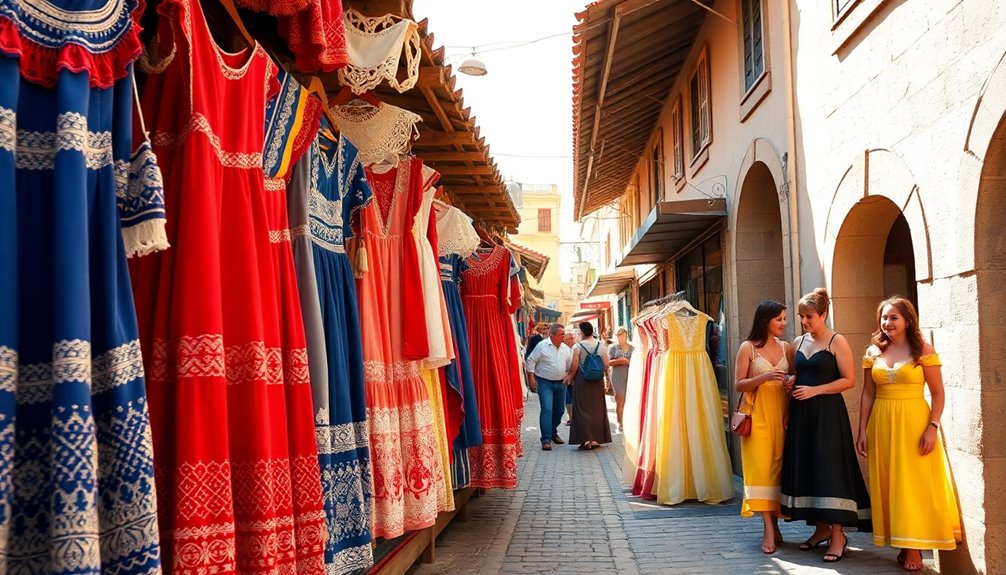
Shopping for dresses in Spain offers a delightful blend of local flair and European elegance. You'll find a variety of stylish dresses in both local boutiques and well-known fashion chains like Zara and Mango. These shops showcase the latest European trends, ensuring you're always in style.
Before you dive in, remember that Spanish sizing usually runs smaller than American sizes. It's a good idea to try on dresses or check size charts to avoid any surprises.
While exploring the streets, keep an eye out for seasonal markets and pop-up shops, where you can discover unique, handcrafted dresses that reflect local craftsmanship—perfect for a memorable souvenir.
If you prefer online shopping, platforms like ASOS and Zalando make it easy to access a broad selection of Spanish and European dress styles from the comfort of your home.
When choosing dresses, consider the climate and the occasion. Opt for breathable fabrics that can transition smoothly from daytime outings to elegant evening events.
With this shopping guide, you're well-prepared to find the perfect dress that embodies the essence of stylish European fashion!
Upcycling Vintage Fashion Pieces
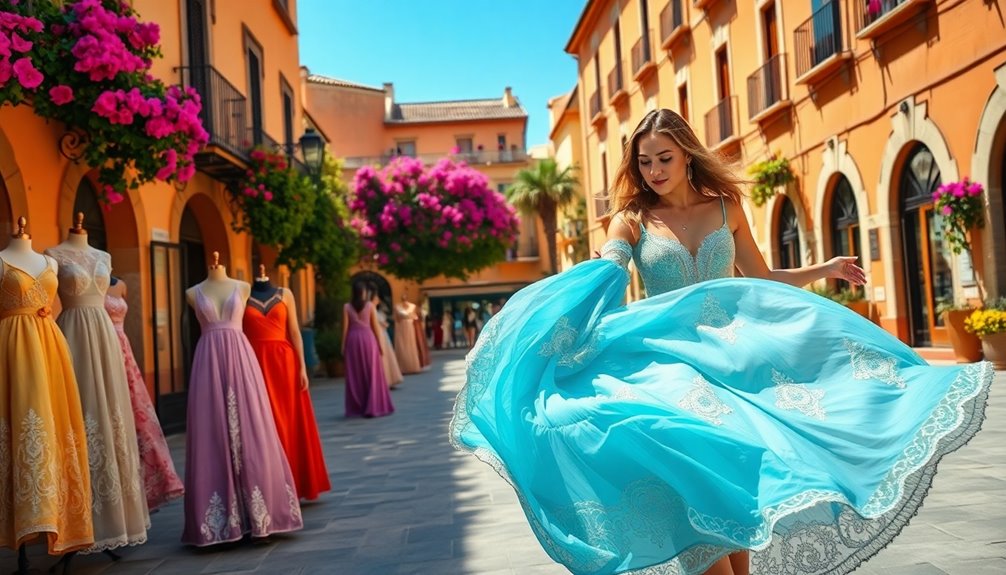
You can creatively repurpose old clothing by adding unique embellishments that showcase your personal style. This process not only breathes new life into vintage pieces but also helps reduce waste in the fashion industry. Additionally, using materials that are eco-friendly ensures that your fashion choices align with sustainability values. Let's explore how you can transform forgotten garments into standout outfits that reflect your individuality.
Repurpose Old Clothing Creatively
Frequently, people overlook the potential hidden in their old clothing, but upcycling vintage fashion pieces can transform these forgotten garments into unique, stylish creations. You can repurpose old clothing by using techniques like cutting, sewing, and dyeing. This not only breathes new life into outdated items but also allows your personal style to shine through.
Consider the distinct cuts and materials of vintage clothing, which give your upcycled pieces an appealing charm that mass-produced fast fashion lacks. By exploring thrift stores and online marketplaces, you'll discover a treasure trove of vintage options just waiting for a creative touch.
The upcycling trend has gained traction among eco-conscious consumers, with a notable 54% increase in the interest in sustainable fashion from 2020 to 2021. This growing movement encourages you to think outside the box and see your old garments as a canvas for creativity rather than waste. Additionally, incorporating essential oils into your upcycled pieces can enhance their appeal through delightful scents that promote emotional wellbeing.
Repurpose With Unique Embellishments
Transforming vintage fashion pieces into something fresh and exciting can start with unique embellishments that add character and style. By upcycling vintage fashion, you can breathe new life into old garments, creating a personalized piece that truly reflects your taste.
Think about adding lace, embroidery, or fabric patches to enhance the original design. These unique embellishments can turn a simple dress into a statement piece.
You can also repurpose vintage dresses by altering the hemline or adding a trendy belt to define your silhouette. If you're feeling adventurous, try combining different vintage pieces to craft a layered ensemble that aligns with current trends. This not only showcases your creativity but also keeps the spirit of the original fashion alive.
Embracing upcycled fashion supports a circular economy, reducing waste while encouraging a sustainable mindset. In Spain, many artisans and designers are leading the way, showcasing their upcycled creations at local markets and boutiques. Additionally, learning about age-appropriate discipline methods can help you instill a sense of responsibility in your children as they grow up surrounded by your creative endeavors.
Cultural Impact
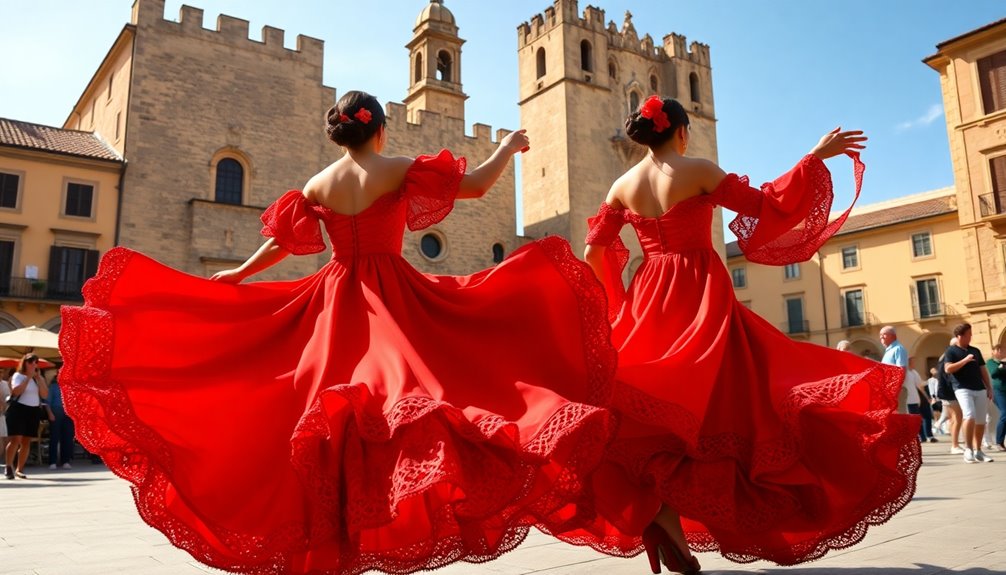
When you explore fashion in Spanish cinema, you'll notice how dresses not only tell stories but also reflect cultural values and social movements.
Fashion-driven activism is another powerful force in Spain, using attire as a medium for change and expression.
Together, these elements showcase the profound cultural impact that dresses have on both individual identity and societal conversations.
Fashion in Spanish Cinema
Spanish cinema is a vibrant tapestry that intricately weaves fashion into its storytelling, captivating audiences with its rich visual culture. The costumes you see in films like "Volver" and "Talk to Her" aren't just clothing; they embody Spain's diverse regional styles and traditions.
You'll notice traditional garments, such as flamenco dresses, beautifully juxtaposed with modern style, illustrating how heritage can seamlessly blend into contemporary fashion.
Notable Spanish designers like Agatha Ruiz de la Prada and Pedro del Hierro have made significant contributions to this cinematic fashion landscape, enhancing the global perception of Spanish fashion.
Their work in film not only showcases their creative genius but also introduces audiences to unique fashion statements that resonate on both personal and cultural levels.
In these films, characters often embody a balance between tradition and modernity, inspiring you to incorporate bold colors and striking patterns into your wardrobe.
Fashion-Driven Activism in Spain
Fashion-driven activism frequently takes center stage in Spain, utilizing clothing as a powerful tool for social change. This movement has blossomed into a vibrant force, advocating for social justice, environmental sustainability, and cultural identity.
The "Fashion Revolution" movement, sparked by the Rana Plaza disaster, emphasizes transparency in the garment industry and champions ethical production practices, urging consumers to demand more from their favorite brands.
You'll notice Spanish designers increasingly incorporate sustainable materials into their collections, reflecting your growing desire for eco-conscious fashion choices. This shift not only addresses environmental concerns but also promotes fair labor practices, ensuring that artisans receive fair compensation.
Events like Madrid Fashion Week showcase collections that challenge traditional beauty standards and celebrate body positivity, illustrating the cultural impact of fashion activism.
Moreover, collaborations between fashion brands and local artisans are on the rise, fostering cultural preservation and economic empowerment. This blend of contemporary fashion with traditional craftsmanship enriches the Spanish fashion landscape, allowing you to wear pieces that tell a story while making a statement. Additionally, the integration of educational toys into children's playtime can support their cognitive and emotional development, paralleling the way that fashion can influence social awareness and personal growth.
Frequently Asked Questions
How Do You Dress in Spain and Not Look Like a Tourist?
To dress in Spain and avoid looking like a tourist, you'll want to choose well-fitted clothing in neutral shades.
Skip oversized or flashy outfits and layer with chic jackets or lightweight scarves.
Opt for stylish, comfortable footwear like leather flats instead of athletic shoes.
Avoid casual items like flip-flops, and choose tailored shorts or maxi dresses.
When visiting religious sites, cover your shoulders and wear long skirts or pants to respect local customs.
How to Not Stand Out as an American in Europe?
To not stand out as an American in Europe, you should choose clean-cut, well-fitting clothing in muted colors like black, navy, or beige.
Avoid athletic gear and opt for stylish sneakers instead.
When visiting religious sites, dress modestly by covering your shoulders and knees.
Aim for versatile outfits that transition from day to night, and research local fashion trends to ensure your wardrobe reflects contemporary styles common in your destination.
What Is the Dress Style in Spain?
In Spain, you'll find a dress style that's modern yet chic, favoring well-fitted clothing.
You'll often see locals in jeans and jackets during spring and summer, adapting to the mild climate.
For evenings, smart casual outfits are the norm, with women choosing stylish dresses or combinations of tops and trousers.
Embrace bright colors and flowing fabrics in summer, but remember to dress modestly when visiting religious sites.
It's all about quality and sophistication!
What Is the Difference Between American and European Fashion Style?
American fashion leans toward casual, oversized fits and bright colors, while European fashion, especially in Spain, favors clean-cut, well-fitted styles in muted tones.
You'll notice that Europeans often dress up for outings, prioritizing polished looks and accessorizing with scarves and statement jewelry.
Layering is key in Europe for versatility, whereas Americans typically opt for single-layer outfits.
This difference highlights a more relaxed, informal vibe in American style compared to the chic sophistication of European fashion.
